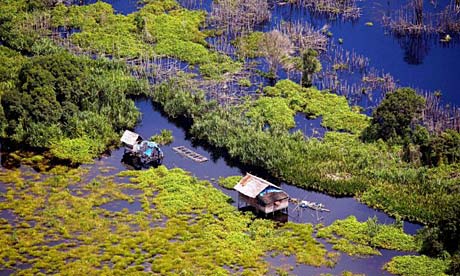The Indonesian Rainforests hold the most crucial ecological stands of tropical rainforest in the world. Their extremely rich biodiversity in the world and keeping of affluent amount of carbon out of our atmosphere contribute to our environment significantly.
1. Biodiversity
The forests have 10% of the world's mammal species, 16% of bird species, and 11% of all plant species. In addition, the forests hold over 3,000 different types of timber. Moreover, their endemism level of 40 demonstrates the ecosystem contains unique plants/animal species.
Indonesian Rainforest is a home for animals such as orangutans, tigers, elephants, and rhinos.
2. Carbon Storage
Indonesian Rainforests have a large carbon-storage capacity. Particularly, the peat in the region acts like a "carbon sponge" in addition to the trees.
Photograph. Canopy: Transforming Business for our planet Web. 27 Nov 2013. <http://canopyplanet.org/what-we-do/protecting-ancient-forests/indonesias-rainforests/>.

Irvine, Georganne. Orangutans in Indonesian rainforests. N.d. Photograph. Orangutan Foundation International Web. 27 Nov 2013.
<http://www.orangutan.org/rainforest/indonesian-forest-facts>
[3] Peatlands
1. Biodiversity
The forests have 10% of the world's mammal species, 16% of bird species, and 11% of all plant species. In addition, the forests hold over 3,000 different types of timber. Moreover, their endemism level of 40 demonstrates the ecosystem contains unique plants/animal species.
Indonesian Rainforest is a home for animals such as orangutans, tigers, elephants, and rhinos.
2. Carbon Storage
Indonesian Rainforests have a large carbon-storage capacity. Particularly, the peat in the region acts like a "carbon sponge" in addition to the trees.
[1] Elephants in Indonesian Rainforests


Photograph. Canopy: Transforming Business for our planet Web. 27 Nov 2013. <http://canopyplanet.org/what-we-do/protecting-ancient-forests/indonesias-rainforests/>.
[2] Orangutan in Indonesian Rainforests

Irvine, Georganne. Orangutans in Indonesian rainforests. N.d. Photograph. Orangutan Foundation International Web. 27 Nov 2013.
<http://www.orangutan.org/rainforest/indonesian-forest-facts>
[3] Peatlands

No comments:
Post a Comment